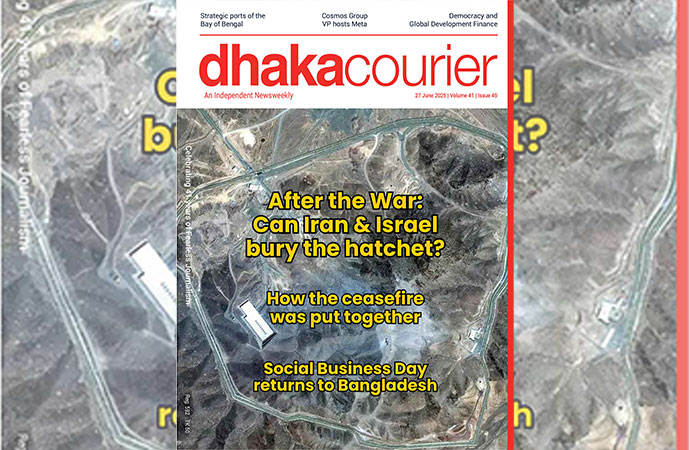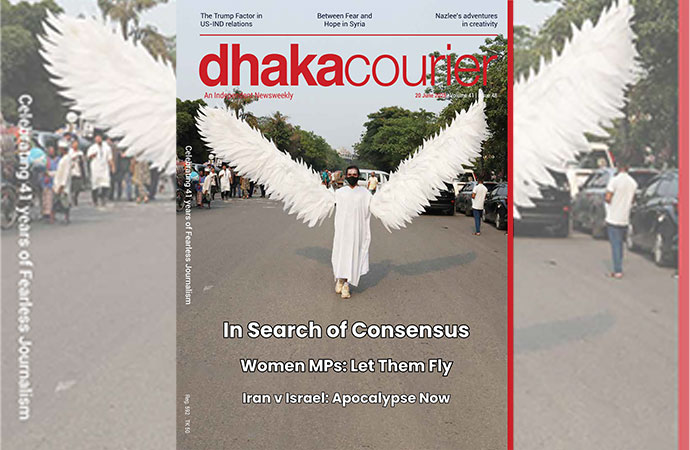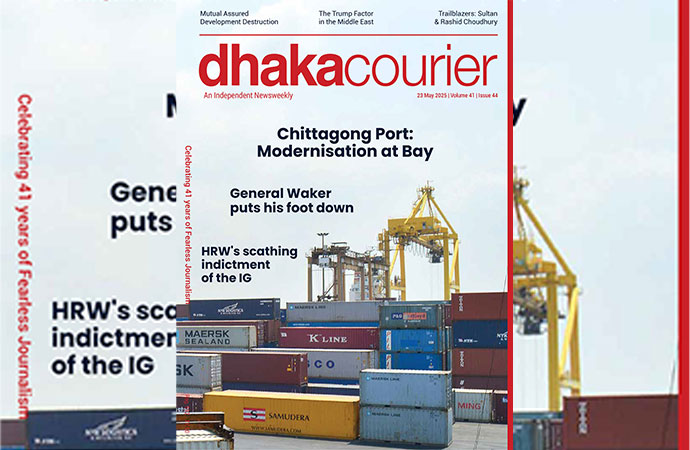Reportage

Chinese President Xi Jinping chairs the leaders’ roundtable meeting of the second Belt and Road Forum (BRF) in Beijing
The inexorable rise of China as an economic superpower has invited disturbing bouts of insecurity on the part of the Western alliance at various times over the course of the last three decades. Time and again the Chinese state has been forced go the extra mile to defend its 'peaceful rise', at one point even working that phrase into official policy. Aspersions cast by Western officials anxious to maintain the post-World War II order in international affairs has seen China develop its "win-win" concept in foreign policy, all the better to set nations it dealt with at ease. Yet nothing that has gone before could match the sheer alarm that has been emanating from that most important of Western capitals, Washington, ever since a certain real estate billionaire-turned reality television star moved into its most famous address at 1600 Pennsylvania Avenue, otherwise known as the White House.
Donald Trump's conflict with the Asian powerhouse began during his presidential campaign, when he promised to stop what he described as "China's longtime abuse of the broken international system and unfair practices." Steve Bannon, his former consigliere, has compared China to 1930s Germany, warning the country could go down the same dark path if the US fails to challenge its rise. To that extent, Trump's actions since taking over as president in 2017 will hardly have raised eyebrows. The administration's national security strategy paper set the stage, promising "competition and resistance to Chinese trade and other abuses."
After initially reaching out to Chinese President Xi Jinping, the second year of the Trump presidency saw the US ratchet up a trade war (that most likely neither can win) against Beijing with the imposition of tariffs on $250 billion-worth of Chinese goods. Trump even threatened to target all Chinese exports to the US. Beijing was forced to respond by imposing tariffs on $110 billion-worth of US products. The world's two major economies being at loggerheads almost throughout the year saw trade growth, a key artery in the global economy, slow markedly to around 4 percent in 2018 from 5.25 per cent in 2017, according to the OECD.
More recently we have witnessed the US set its sights on Huawei, a Chinese telecoms equipment maker whose lead over the rest of the global industry in next generation 5G technology for wireless networks is said to be such that it is practically irreplaceable for many wireless carriers that want to be among the first to offer the new services. Yet last August, the US president signed into law the National Defense Authorization Act (NDAA), of which Section 889 bars US federal agencies and their contractors from procuring Huawei equipment and services. It's precisely the sort of singling out of a multinational corporation or company that US would never countenance against one of its own.
In one of the latest episodes that demonstrated just how seriously the US, or at least its present administration, is taking the perceived 'China threat', Washington rushed to warn Italy against signing on to what stands out as China's most ambitious economic effort to date on a global scale, the Belt and Road Initiative (BRI), denouncing it as a "vanity project."
In a thinly veiled rebuke of the initiative, which aims to unite European and Asian markets, a spokesman for the White House's group of national security advisers said that Italy's participation in the BRI would add "legitimacy" to Beijing's infrastructure project.
"Italy is a major global economy and great investment destination. No need for Italian government to lend legitimacy to China's infrastructure vanity project," spokesman Garrett Marquis said on Twitter.
Bannon, who happened to be in Rome at the time in his new-found role as some sort of global emissary for far-right populist movements, called on the Italian government to rethink its position. "I beseech the people of Italy to look at China's predatory economic model before signing any deals," he told reporters. "The Chinese have a rapacious appetite for global domination."
It didn't work. Defying the pressure from its US ally, the Italian government entered into a memorandum of understanding with its Chinese counterpart signaling Italy's participation in the BRI in late March. In total, Chinese investors accompanying their president signed twenty-nine separate deals amounting to $2.8 billion worth of projects. Most notably, they agreed to invest in port infrastructure in Trieste, Genoa, and Palermo, which could give Chinese goods faster access to Europe. According to the Council on Foreign Relations, a respected US think-tank, Italy's signature marks a turning point-it is the first Group of Seven (G7, a rich countries' club) nation and the largest EU member to accept BRI funds.
And why not?
Nothing to fear but....
One of the ways, perhaps the principal way in which China's critics have sought to discourage other countries from joining the BRI has been to depict Beijing's outreach efforts to promote the initiative through its largesse as a form of "debt trap diplomacy," - a more sinister ploy through which China intended to bend debtor countries to its will by burdening them with huge infrastructure loans. These fears have been increasingly visited upon Bangladesh as well, since joining the initiative during Xi Jinping's visit to Dhaka in October 2016. Some of the key infrastructure projects of the country like the Padma Bridge and Karnaphuli Tunnel fall under under the BRI.
The fearmongering around Chinese debt became serious enough that the Chinese Embassy in Dhaka was forced to address the issue head on recently, ahead of the Second Belt and Road Forum, a summit of sorts centred on the BRI, that was held in Beijing this past week.
Forcefully defending the initiative, Charge d' Affaires of the Chinese embassy Chen Wei said "the theories" that posit the BRI as a geopolitical tool of China, or a possible debt trap for relevant countries, are totally off the mark, reveal prejudices, and amount to nothing more than smears against the BRI. He pointed out that China is a late entrant to the international finance markets and its loans account for only a low percentage in the national debt of the relevant countries.
"Four-fifths of development loans China gives out are below the market interest rate," he said.
Citing a report of the central bank of Sri Lanka, he said the China-related debt there accounts for merely 10.6 percent of its total, within which 61 per cent is at an interest rate far below the international market. He noted that not a single country has so far been trapped into a debt crisis for joining the BRI.
Referring to Bangladesh, he said, China mostly encourages foreign direct investment (FDI) that creates jobs and contributes to the country's inclusive growth.
"If you look at the government to government (G2G) arrangement, we provide soft loans. The interest rate is between 2.0 per cent and 3.0 per cent. We don't even encourage this loan. We promote investments for Bangladesh," he said.
Under the BRI, a lot of qualified Chinese companies come to Bangladesh to help construct roads, bridges, power stations, and water facilities. Currently there are over 200 Chinese companies operating in Bangladesh, with Chinese SMEs in even larger number.
"Bangladesh has become the biggest Engineering, Procurement and Construction (EPC) market of China, and non-financial direct investment from China has increased by leaps and bounds," he said.
Prof Li Tao, Executive Director of the Institute of South Asian Studies at Sichuan University in China, recently told our sister newsagency UNB that Bangladesh holds an important 'geopolitical strategic position' in the BRI that offers 'great potential' to strengthen economic and trade cooperation between Bangladesh and China.
"We should strengthen cooperation between the two governments, and at the same time focus on strengthening inter-party exchanges," she said.
Judging from the Bangladesh government's enthusiasm around the 2nd BRF, the feeling might just be mutual. And justifiably so.
Ahead of the summit, the Prime Minister's International Affairs Adviser Dr Gowher Rizvi said Bangladesh is "proud to be a part of the BRI".
"Bangladesh needs huge financial resources and technological support to upgrade the infrastructure, make rapid industrialisation and create millions of jobs to eradicate poverty. China can extend a helping hand in this regard," said Industries Minister Nurul Majid Mahmud Humayun, while addressing summit in Beijing.
Mahmud Humayun, who led the Bangladesh delegation, also sought to promote the BCIM (Bangladesh China India Myanmar) Economic Corridor, a project connecting China with South Asia and the resourceful Indian Ocean, that was listed in the set of projects under BRI 2 years ago, but went conspicuously missing this year, possibly over India's continued snub of the initiative.
Dhaka has recently also called upon Beijing to speed up the process to sign loan agreements for several projects following up on the agreements reached during Xi's October 2016 visit. Deals involving only five out of 27 projects that were floated at the time have actually been inked since the two countries signed the framework agreement during Xi's visit.
The five projects that have got going involve financing of $4.5 billion, against a total of $22.5 billion for the 27 projects.
Not looking back
While no proponent of shying away, Dr Fahmida Khatun, executive director of the Centre for Policy Dialogue, a Dhaka think-tank, does advise caution when it comes to taking on massive amounts of debt from China.
"Although, Bangladesh can attract huge amount of overseas investment through the Belt and Road Initiative, we also have to follow a cautious approach to ensure that our national interest is preserved in the long term," she said. The economist noted that there are some controversies regarding Chinese Investment coming through BRI around the world.
"International experience suggests that the lack of transparency is a big issue for Chinese projects. Countries also often struggle to pay off Chinese debts - which also results in bitter consequences for the recipient countries," she added.
Her warnings would probably apply to taking on too much debt from any one nation, be it China or otherwise. Despite all the speculation and Cassandra-like predictions, no country till today has claimed that it is somehow being enmeshed by BRI-related financing from China. Nor did any BRI project incur a systemic debt problem in its host country.
Statistics revealed by Philippine Finance Secretary Carlos Dominguez showed that at the end of 2022, the government's debt to China would only be 4.5 percent of its total, less than half of that to Japan, which would account for 9.5 percent of the total.
The Belt and Road Initiative has already reaped tangible results in the six years since its birth in 2013, as the 2nd BRF amply demonstrated. It has also accumulated worldwide support. So far, 126 countries and 29 international organizations have signed up to the initiative.
Flourishing BRI cooperation has over the years helped nurture faster trade and investment flows, allowed for easier financial access, and created more extensive people-to-people exchanges across Asia, Europe, Africa and beyond.
Two years ago, when addressing the opening of the first Belt and Road Forum for International Cooperation (BRF), Chinese President Xi Jinping said, "We are ready to share practices of development with other countries, but we have no intention to interfere in other countries' internal affairs, export our own social system and model of development, or impose our own will on others. In pursuing the Belt and Road Initiative, we will not resort to outdated geopolitical maneuvering."
As testimony to the BRI's relevance and significance in today's world, its vision has been included in documents of major international institutions and cooperation platforms, including the United Nations, the Group of 20, the Asia-Pacific Economic Cooperation and the Shanghai Cooperation Organization.
Guided by the Silk Road spirit, the initiative aims to promote cooperation in five major areas -- policy coordination, infrastructure connectivity, trade, finance and people-to-people exchanges.
On financial cooperation, China works with its BRI partners and major global financial institutions to ensure a diversified and strong flow of funds for key BRI-related projects.
Since its launch in 2016, the Asian Infrastructure Investment Bank (AIIB) has become one of the key multilateral platforms for BRI construction, and has won growing global trust and recognition. As of the end of 2018, the AIIB had 93 members, and had approved loans of 7.5 billion U.S. dollars on 35 projects in 13 countries including Indonesia, Pakistan, Tajikistan, Azerbaijan, Oman, Turkey and Egypt.
Over the past six years, total trade between China and other countries participating in the BRI has exceeded 6 trillion dollars, and China's investment in these countries has surpassed 80 billion dollars. Also, the latest studies by the World Bank and other international institutions show that BRI cooperation will cut the costs of global trade by 1.1 to 2.2 percent and contribute at least 0.1 percent of global growth in 2019.
Also, the BRI is making a difference that ordinary people can feel. A recent World Bank report shows that BRI-related investments can help lift 8.7 million people from extreme poverty and 34 million from moderate poverty in a variety of countries.

























Leave a Comment
Recent Posts
Cosmos Group VP Nahar Khan hos ...
A visiting delegation from Meta, the parent company of Facebook, Insta ...
Break the gloom, build a bette ...
Emphasising the transformative power of social business and its strong ...
‘Mobocracy’ must not prevail
The US Supreme Court allowed the Trump administratio ..
Germany dependable partner in our development journe ..
15th edition of Social Business Day: Prof Yunus to j ..